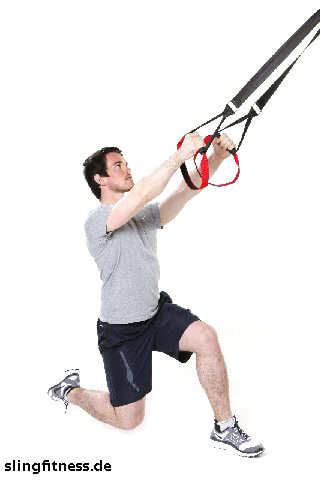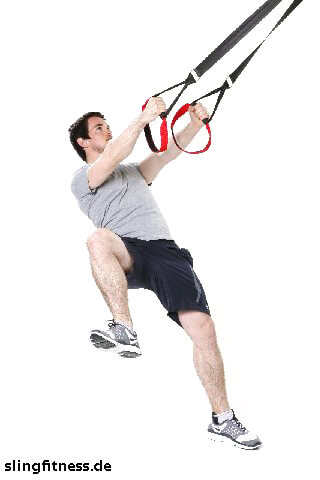Primary: legs, Glutes (quadrizeps, ischiocrurale M., iliopsoas, ab-/adduktoren, soleus, gastrocnemius)
Secondary: Back, Arms (latissimus, erector spinae, bizeps brachii, palmarflexoren)
The one-legged squat requires a good stability and balance of the supporting leg. By lowering the buttocks backward the knee joint gets relieved and the muscles get specifically trained. The swinging leg is placed diagonal backward. The knee hub specifically trains the gluteal muscles.
The following figures illustrate the exercise Squat One-Legged with Sidewise Knee-Hub:
 |
 |
| Suspension Training Leg Exercises | |
|
Starting Position The arms are stretched and the back is straight. The weight is on the heel of the supporting leg. The back leg is lowered far down backwards. The knee of the swinging leg points towards the ground and is strongly flexed. |
Final Position In the final position the arms are stretched and the back is upright. The weight is on the heel of the lightly flexed supporting leg. The knee of the lifted leg is turned outward. |
|
Movement 1 The body is moved backwards by a flexion of the supporting leg down backwards. At the same time the swinging leg is flexed and lowered backwards as well. |
Movement 2 Then the body is raised up by the power of the supporting leg, the supporting leg is stretched in the hip and the knee joint. Simultaneously the free knee is raised up to hip level and turned outward. |
|
Hint: The weight has to be completely on the heel of the supporting leg. The more you pull your knee upward and turn it out, the bigger is the tension in the great gluteal muscle and hip flexor. |
|
